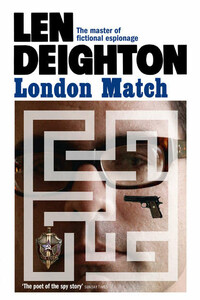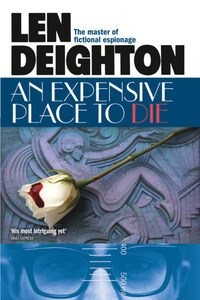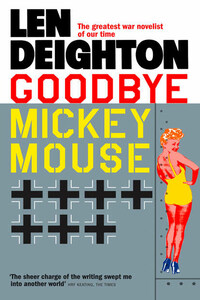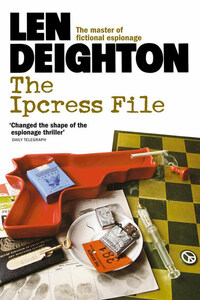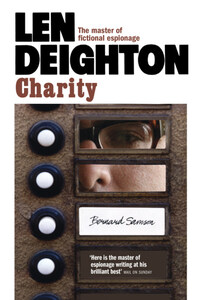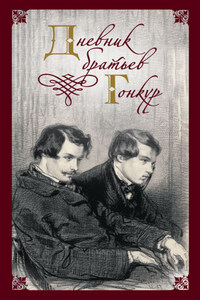On reading a synopsis for one of Len Deighton’s trilogies I was immediately taken by the sentence, ‘And we are back in the mazes of Secret Service mystery and intrigue – mazes that now lead into Samson’s own tangled past.’ There I found my concept for the London Match cover! I would place him within the maze, trapped, with pathways leading to danger, in the form of the gun, and perhaps worse, the KGB, represented here by one of the agency’s badges – this Soviet-era icon features the hammer and sickle together with Cyrillic letters for ‘KGB’ and ‘USSR’.
Some years ago I was commissioned to design a calendar for a leading British sign company. I decided to use the many door numbers that I had photographed during my travels around the world, showing a different number for each day of the year. I contacted the Prime Minister’s press secretary, who kindly gave me permission to photograph the door of Number 10 Downing Street. This photograph has once again found a good use adorning the back cover of this book of intrigue in London’s Whitehall.
At the heart of every one of the nine books in this triple trilogy is Bernard Samson, so I wanted to come up with a neat way of visually linking them all. When the reader has collected all nine books and displays them together in sequential order, the books’ spines will spell out Samson’s name in the form of a blackmail note made up of airline baggage tags. The tags were drawn from my personal collection, and are colourful testimony to thousands of air miles spent travelling the world.
Arnold Schwartzman OBE RDI
Published by HarperCollinsPublishers Ltd
1 London Bridge Street
London SE1 9GF
www.harpercollins.co.uk
First published in Great Britain by Hutchinson & Co. (Publishers) Ltd 1985
Copyright © Pluriform Publishing Company BV 1985
Introduction copyright © Pluriform Publishing Company BV 2010
Cover designer’s note © Arnold Schwartzman 2010
Cover design and photography © Arnold Schwartzman 2010
Len Deighton asserts the moral right to be identified as the author of this work.
A catalogue copy of this book is available from the British Library.
This novel is entirely a work of fiction. The names, characters and incidents portrayed in it are the work of the author’s imagination. Any resemblance to actual persons, living or dead, events or localities is entirely coincidental.
All rights reserved under International and Pan-American Copyright Conventions. By payment of the required fees, you have been granted the non-exclusive, non-transferable right to access and read the text of this e-book on screen. No part of this text may be reproduced, transmitted, down-loaded, decompiled, reverse engineered, or stored in or introduced into any information storage and retrieval system, in any form or by any means, whether electronic or mechanical, now known or hereinafter invented, without the express written permission of HarperCollins.
Source ISBN: 9780008125004
Ebook Edition © March 2015 ISBN: 9780007387205
Version: 2017-05-23
Despite its title, London Match is a book largely about Berlin. The Berliners were familiar to me; their general demeanour; their humour closely resembled the cocky Londoners I grew up among. But the physical texture of Berlin is not like London, which is generously ventilated with parks and squares. Berlin is martial and monolithic and always has been. Berlin is like no other town I have ever seen. It fascinates me, and in many ways it became my home but there is no denying its grim grey ugliness. Its wide streets make the unrelenting vista of apartment blocks seem less oppressive. But only slightly so. To cope with overcrowding, the great apartment blocks were built one behind the other. Some tenements were so vast that there were three or four Hinterhöfe – or back courtyards. These were so small that sunlight was lost before it could find its way into the hintermost yard. In the early thirties it was calculated that more than ninety per cent of Berlin’s population were packed tightly into these grim five-storey buildings. Berlin, expanded by reparations of the Franco–Prussian War, was designed to absorb the impoverished agricultural workers who came flooding from the Eastern lands seeking jobs in the factories and sweatshops.
Ugly, dirty and crowded – sweaty in summer and freezing in winter – what is the secret attraction of this town? The population is a part of it. The endless upheavals of the past century have brought a weird mixture of people to a town that has never found its place in history. And like many others regularly brought to the brink of despair, Berliners have learned how to smile. Always from the east, there came to the city a steady stream of people looking for shelter. Persecution drove many, and revolution brought more. Painters and writers such as George Grosz and Alfred Döblin provided a lasting record of a town where skirts were short and pounding jazz was at its most frenetic. Emperor Wilhelm had disappeared into exile and Czarist Dukes were working as nightclub doormen. Sex, psychology and cycle racing were major obsessions, and money was singularly meaningful in a town where the currency had collapsed to zero time and time again.
